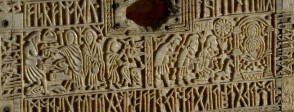Download photos of each side of the casket from For the classroom. Divide the class into groups and print out a set of photos for each group. Ask students to annotate each panel, labelling any people, animals, objects or buildings they can see and what they think is happening. Discuss as a class and then introduce the actual stories. Stress how these stories have derived from different traditions. What can they suggest about Anglo-Saxon beliefs based on this?
Look at other, later depictions of the Adoration and Romulus and Remus and notice similarities and differences. Compare the pendant showing Romulus and Remus in A bigger picture.
The next three ideas concentrate on exploring Anglo-Saxon culture based on the scenes and inscriptions on the Franks Casket.
Draw students’ attention to the runic inscriptions. Introduce them to riddling and ask if they can work out what the casket was made out of by solving the riddle on the front. Use the link in For the classroom to find more Anglo-Saxon riddles for students to solve. Then ask them to try to write some riddles and see if a partner can work out what the answer is. Share the hardest riddles with the class.
Move from riddles to kennings and use the link in For the classroom to explore these. Listen to the extract from Beowulf in For the classroom. There are lots of poetry writing opportunities that arise from this.
Use the British Museum lesson plan under More information in the About the object section. Read the story of Weland the smith and compare it with the version shown on the casket. The lesson plan has details of the image.
Find out more about Northumbria and its importance in the Anglo-Saxon period. Object file: Anglo-Saxon stained glass will be helpful here.
The next two enquiry ideas use the objects in A bigger picture.
What happened to the Britons who were left behind after the Romans left? Ask students to work out how objects could tell us whether people moved away or stayed in the same place as the Anglo-Saxons arrived. How else did they adapt to the new way of life? Object file: Figure of an Anglo-Saxon man would be useful to use for this.
Why did the Anglo-Saxons want to identify with the Roman empire? Ask students to research the reasons why Anglo-Saxon kings and queens might have wanted to suggest that they were like the Roman Emperors and their wives. Use the objects to identify ways they did this using some examples of fully Roman coins and other objects.
The next ideas use the Franks casket and the two other caskets from the later medieval period in For the classroom.
Print out images of the later medieval caskets and ask students to look closely at the closing mechanism. They all have locks. What might have been stored in the casket that needed to be locked away? Who were the caskets for if they were locking away precious things? What does that tell us about the Franks casket? Do they think it was lockable? How do they know? What do they think was kept in it?
You can also do some maths and design work. What 3D shapes are the caskets? Ask students to design nets that, when folded, would make these caskets – the dimensions are given in For the classroom. Then have a go at making a casket - remind students to leave tabs on each connecting side, and to design it so the lid can open and shut. Students could draw a scene to decorate each panel of their casket. They could choose famous figures from history, religious stories, world folk tales, or scenes from children’s literature and could make each panel independent or relate them to each other. Can the other students explain which stories are illustrated and why the choices have been made?


